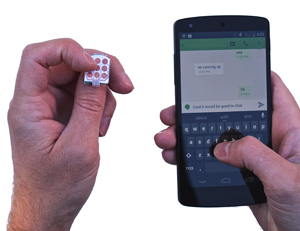 Most wearables today are finding a home on our wrists. A smaller number are making their way onto other body parts, including our heads and fingers. MIT Media Lab has developed one that sits right on your fingernail. Inspired by stick-on nail art, NailO is a small sticker that attaches to a nail to act as a small trackpad to control your smartphone or other mobile devices with discrete motions. It can also be personalized thanks to nail art, potentially making each one unique.
Most wearables today are finding a home on our wrists. A smaller number are making their way onto other body parts, including our heads and fingers. MIT Media Lab has developed one that sits right on your fingernail. Inspired by stick-on nail art, NailO is a small sticker that attaches to a nail to act as a small trackpad to control your smartphone or other mobile devices with discrete motions. It can also be personalized thanks to nail art, potentially making each one unique.
From the fashion-conscious, to techies, and anyone in between, NailO can make a style, art, or a design statement; but in its more neutral, natural-looking example it can be worn and used only for its functionality. As a nail art sticker, NailO is small, discreet, and removable. Interactions through NailO can be private and subtle, for example attracting minimal attention when you are in a meeting but need to reply to an urgent text message. Mimicking the form of a cosmetic extension, NailO blends into and decorates one’s body when attached, yet remains removable at the wearer’s discretion, giving the wearer power and control over the level of intimacy of the device to one’s body.
The NailO can detect a number of gestures including presses and swipes in four directions. With additional NailO stickers on other fingers, it even supports multi-finger gestures. The movements are discrete enough not to attract attention in a meeting or other occasion where playing with your smartphone might be frowned upon. Nails make an ideal surface for NailO as they are hard surfaces with no nerve endings. A stick-on on a nail will not impair movement or cause any discomfort.

The NailO consists of four layers. The first is the art itself. Underneath are the sensors, a circuit board which includes an ATmega328 (Atmel) microcontroller and MTCH6102 (Microchip) capacitive touch controller and a 10mAh battery. It pairs to other devices using Bluetooth 4.0 via a Bluetooth Low Energy chip nRF8001 from Nordic Semiconductors.
Commercial release is still about three years away. As one would expect from a wearable that size and thickness, finding a suitable battery is one of the challenges that will need to be solved. The team is already in discussion with some battery manufacturers in China to come up with a battery only half a millimeter thick.
